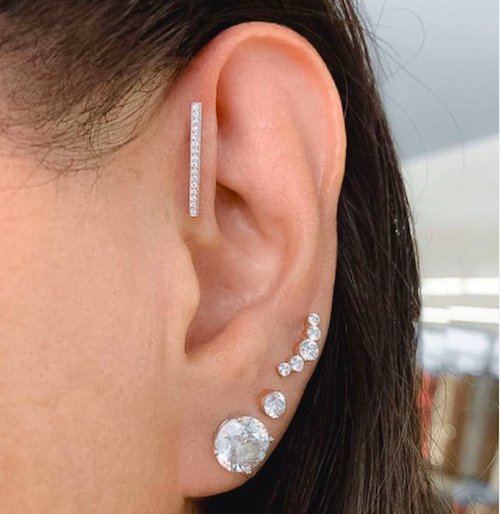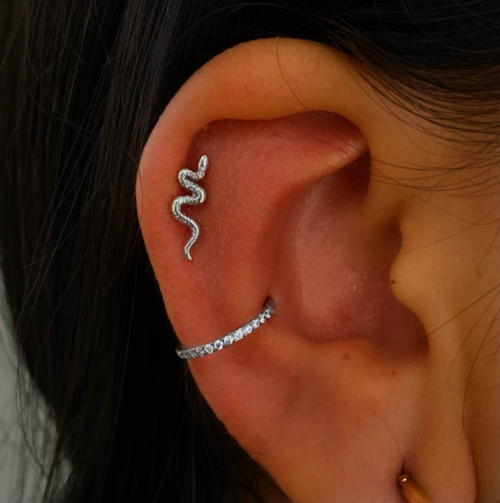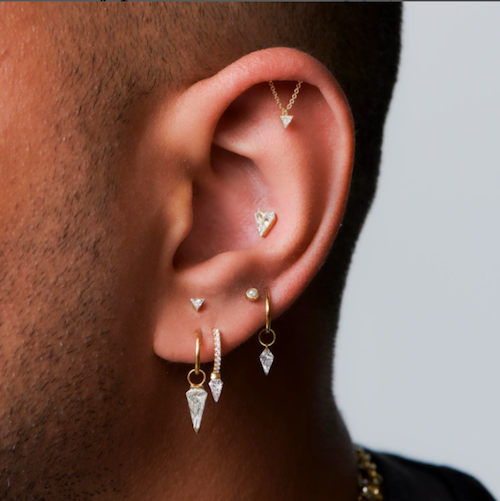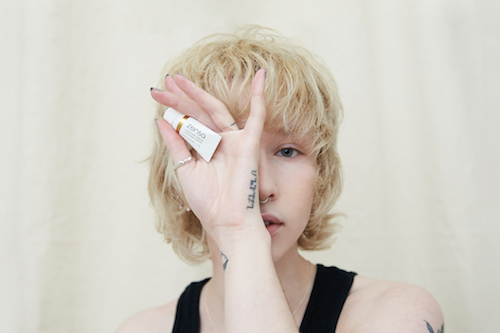Your Guide To Cartilage Ear Piercings: 10 Types To Know
Your Guide To Cartilage Ear Piercings: 10 Types To Know
Cartilage piercings elevate your curated ear to expand your options beyond your trusted lobe piercings. Especially if it's been years since you got your first (standard) lobe piercing, the thought of getting a cartilage piercing can be a bit intimidating. Cartilage piercings describe any ear piercing above the lobe. These piercings take longer to heal and are relatively more painful than lobe piercings. For reference, the average lobe piercing healing time is around 6-8 weeks and generally ranks at around a 2/10 on the pain scale. Common cartilage piercing types include helix piercings, daith piercings, conch and tragus piercings. Some other popular cartilage ear piercings are the forward helix, anti-tragus, rook, snug, orbital and industrial piercings. Explore the ear-piercing chart to help you better visualize how these placements look on the ear.

Credit: Fresh Trends/Pinterest
Every cartilage piercing comes with its own healing time and pain level expectations. Aside from stylistic preferences, the cartilage piercing(s) you choose depends on your unique ear shape and anatomy (more on this later). Other factors to consider are your individual pain tolerance, after-care requirements (some placements need more TLC than others) and which ear piercings are most flattering for your face shape.
Read on to learn about the 12 cartilage ear piercing types and everything to know about each one.
Helix Piercing
The helix piercing is the most common and least painful cartilage piercing (generally speaking). Helix placements refer to any piercing on the outer rim of your ear. You can get a double or triple helix for a more layered look. The number of helix piercings you can get depends on your ear shape and size. If you want to get multiple ear piercings at once, consider your personal tolerance for pain and the complexity of the daily after-care you will need to sustain. Helix piercings typically are considered to rest at 4-5/10 on the pain scale. This popular cartilage piercing takes 3-6 months to fully heal. Don’t change the earring or sleep on the side with your fresh piercing throughout this recovery period. Avoiding these practices will reduce the chances of infection or irritation during the wound healing process.
For jewelry, helix piercings are most commonly adorned with hoop earrings. Certain stud or charm earrings can also be worn in a helix placement. Speak with your piercer to discuss your options.

Credit: @thaisbarss/Instagram
Forward Helix Piercing
A forward helix piercing is done on the front-facing cartilage right above your tragus and opposite your hairline. Like a traditional helix, you can get multiple forward helix piercings (double or triple forward helix are a common arrangement). If desired, you often get more than one forward piercing per session. Ask your piercer if this option is right for you.
Like a helix piercing, this piercing should be among the least painful cartilage ear piercings. The forward helix piercing typically is considered around a 5-6/10 on the pain scale. Both types of “helix” placements should hurt less than more intricate cartilage piercings. The entire healing process should take 3-9 months. During the recovery process, avoid changing out your original earring and can lead to irritation or infection in the healing wound.
Small stud earrings typically are worn in a forward helix placement (and will be the jewelry type used in the piercing until it’s fully healed). However, you can also opt for a small hoop earring.

Credit: @mariatash/Instagram
Conch Piercing
The conch piercing is placed along the inner curvature of the ear. There are two types of conch piercings: inner and outer conch piercings. An inner conch piercing is done on the center region of the flat cartilage inside the ear’s shell-shaped curve. An outer conch piercing sits on the flat cartilage between the helix and anti-helix (on the inside part of the ear’s curvature). Your ear anatomy determines whether you’re a candidate for an inner or outer conch piercing. The inner conch piercing is located higher up on your ear and is suitable for individuals with more surface area on the inside of their ears. Outer conch piercings (also called a contraconch piercing) rest lower on your ear and require you to have a flatter surface area near the higher curve of your ear.

(Outer Conch Piercing) Credit: @thaisbarss/Instagram
An inner conch piercing is typically adorned with a stud earring, while hoop earrings usually are worn in an outer conch piercing. Conch piercings provide a lot of surface area to experiment with different earrings and curated ear combinations. With its versatility, it comes as no surprise that conch placements are some of the most popular cartilage piercings. You can get a double or triple conch piercing if desired (all in separate sessions) to maximize your creativity and options for your ear party.
It takes, on average, 3-9 months for a conch piercing to fully heal. During the recovery process, make sure not to sleep on the side that was recently pierced. This practice could tug on the earring and irritate the area (among other discomforts). Conch piercings generally fall at a 6/10 on the pain scale.

(Inner Conch Piercing) Credit: @mariatash/Instagram
Daith Piercing
The daith piercing is located on the small fold of cartilage inside of the ear and is known for its migraine-relieving benefits. This placement sits on an acupuncture pressure point, which might explain its tension-reduction abilities. In terms of pain, daith piercings hover around a 6/10 on the pain scale. While daith piercings don’t necessarily hurt more than other cartilage piercings, they typically stimulate a different sensation. Daith piercings cause many individuals to experience a duller pain, compared to a sharp sensation, than with other piercings. It is normal to feel a dull aching pain for up to a few days after getting the area piercing.
Daith piercings are among the most common cartilage ear piercings because of their stylish look and versatility. There are several earring types you can wear in a daith piercing. Hoops are the most common choice for daith piercings. Captive bead ring and barbell earrings are suitable options as well. Experiment with different variations on these earring styles to elevate your curated ear.
This placement takes 6-9 months to fully heal. However, unlike many cartilage placements, you often can stop worrying about sleeping on the side with your daith around 2 months after getting it pierced.

Credit: @letsearparty/Instagram
Tragus Piercing
The tragus piercing is placed on the small flap of cartilage that covers your ear canal. A tragus piercing is generally regarded as one of the least painful cartilage piercings and looks like it will hurt more than it does. It often is considered around a 4/10 on the pain scale – similar to a helix placement. Tragus piercings should always be done with a needle – never a piercing gun.
You shouldn’t sleep on the fresh piercing until it is fully healed. Avoid using earphones (or earbuds) during the healing process.
Tragus piercings take approximately 6-12 months to completely heal. For jewelry, tragus piercings are often adorned with a small stud earring. Labret styles (a stud with a long post and a flat back plate) will provide the most comfortable fit and not irritate the rest of the ear. Other suitable styles for a tragus piercing include small hoops, captive bead hoops, charm-like studs and small barbells.

Credit: @letsearparty/Instagram
Anti-Tragus Piercing
The anti-tragus piercing is done on the area of cartilage right above the ear lobe (between your ear lobe and tragus). This placement is one of the most sensitive piercings to get. Anti-tragus piercings typically sit around 6-7/10 on the pain scale. It should take 6-12 months for your anti-tragus piercing to fully heal. During the healing process, avoid sleeping on the side with the piercing or using tech accessories like headphones or earbuds. For jewelry, a small hoop or barbell earring is a great option for an anti-tragus piercing.

Credit: @mariatash/Instagram
Snug Piercing
Also known as an anti-helix, the snug piercing is located on the cartilage between the inner conch and outer rim of the ear. Snug piercings are not for everyone –you need to have a pronounced ridge on your anti-helix to be eligible for this piercing type. Consult with your piercer to confirm whether your ear shape allows for this placement. Snug piercings are often considered one of the most painful cartilage piercings you can get. On the pain scale, a snug piercing generally ranks at a 9/10. Snug piercings take around 4-6 months (can take up to 12 months) to fully heal. This cartilage can get irritated easily, so make sure to take good care of this piercing well beyond the recovery time frame.
Proper after-care for a snug piercing includes never sleeping or holding your phone on the side of your new piercing. Avoid using headphones, hats or dirty pillowcases to ensure no bacteria enter the recovering wound. Curved barbells are the most common jewelry option for a snug piercing. A small hoop earring is a suitable option, too. Never switch out the earring until you’re certain that the wound is completely healed.

Credit: Piercing Models/Pinterest
Rook Piercing
A rook piercing is located on the uppermost ridge between the inner and outer rim of your ear. Rook piercings are less common than a helix, daith or tragus piercing – making it a great option for individuals looking to add a unique touch to their curated ear. The rook piercing is considered a 6-8/10 on the pain scale – depending on your pain tolerance and ear shape. This placement goes through a fairly thick area of cartilage. While it’s not the most painful cartilage piercing for most people, be prepared for more pain than expected with a helix or tragus piercing.
Your rook piercing should take approximately 6-12 months to fully heal. For jewelry, small barbell, curved barbell or hoop earrings are the best options for a rook piercing.

Credit: @mariatash/Instagram
Industrial Piercing
An industrial piercing, typically done on the upper ear, describes any two holes connected with a barbell. This placement is also known as a scaffolding or bar piercing. A standard industrial piercing connects helix and forward helix placements. The two separate cartilage piercings are done around 1.5-inches apart and should only be pierced with a needle – never a piercing gun. Industrial piercings rank at around a 7/10 on the pain scale. Industrial piercings take approximately 4-6 months (but can take up to 12 months) to fully heal.

Credit: @mipaespiercer/Instagram
Flat Piercing
As its name suggests, a flat piercing is located on the flat cartilage area between the rook and outer rim of your ear. While flat piercings have risen in popularity over the past couple of years, they still are a unique cartilage piercing type. You can get multiple flat piercings (one at a time, though) to create a cartilage piercing constellation to elevate your curated ear for an edgier take on the lobe constellation trend.
Flat piercings are around a 7/10 on the pain scale and take approximately 3-10 months to fully heal. For jewelry, the flat piercing should be adorned with a stud (either with a flat or bead back), charms or gemstones.

Credit: @mariatash/Instagram
Cartilage Ear Piercing FAQs:
How Much Do Cartilage Piercings Cost?
Most cartilage piercings will cost between $30-80 (up to $100 for an industrial piercing) plus the cost of the jewelry. While these averages are important to keep in mind, the price of your piercing session will greatly depend on your location, studio choice, and piercer’s expertise.
Do Cartilage Piercings Hurt?
The pain from getting a cartilage piercing is relative and depends on the individual’s tolerance. While some placements will hurt more than others, the piercing process (getting the needle through the skin) should only take around 2-6 seconds per hole. Common mishaps, like a paper cut or biting your tongue, probably hurt as much or more than getting most piercings.
If you’re nervous about the pain, read our ranking on the least to most painful ear piercing types to find the best placement option(s) for you.

Finding the right piercer is essential to minimize piercing pain during and after completing the session. An expert piercer can help prevent the area from getting infected (or other issues) that cause discomfort for weeks after your appointment. Do your research and make sure to find a knowledgeable piercer. A thorough search process is especially important if you need to get your ear anatomy assessed to qualify for a more intricate cartilage piercing.
Staying calm – before and during your piercing session – is key. Make sure that you have something to eat and drink before your appointment. Plan some distraction techniques ahead of time if you get nervous in the moment. For some extra protection against potential pain, ask your piercer if using a topical numbing cream would be right for you. If given the green light, apply Zensa Numbing Cream 30-45 minutes before your piercing appointment for best results. Applying ice to the area after your piercing can be helpful for some individuals, too.

What Are The Best After-care Practices For Cartilage Piercings?
Wash the area twice daily with a recommended saline solution or gentle soap and water. Dry it with paper towels to ensure bacteria or other germs don’t infect the area. Avoid going in public pools or bodies of water that could infect the healing wounds. Don’t touch the piercing unless you’re cleaning it, and make sure to wash your hands beforehand. Keep your bedding clean, and do not use your regular towels on the pierced area. Following a healthy diet and lifestyle can also aid in the wound healing process.
What Are The Possible Side Effects To Look Out For When Getting A Cartilage Piercing?
Common side effects include minor bleeding, bruising or redness at the piercing site. These side effects are normal and should go away during the healing process. Infection is a possible (yet usually preventable) side effect that can happen when a cartilage piercing is done incorrectly or with unclean tools. Going to a highly-trained piercer and proper after-care, in most cases, should be enough to prevent an infection.
Another potential side effect of getting a cartilage piercing is keloids. Keloid scars are raised scar tissue that creates a bump around the freshly-pierced hole. While some keloid scars are preventable, others are not and inevitably form during the long (6-12 month) healing process. Keloids are not dangerous but can look unsightly. If you got a keloid scar from one cartilage piercing, you have a higher than average likelihood of developing keloids with future cartilage piercings.
What Jewelry Materials Are Suitable For Cartilage Piercings?
Implant-grade stainless steel, implant-grade titanium and gold are all great options for cartilage piercings. Make sure that your jewelry is nickel-free (it can irritate the skin, especially if you’re allergic) and that any gold earrings are at 14k gold. 18k gold or higher is too soft for a new piercing and could harbor unwanted bacteria.
Ear Piercing Guides:
12 Top Ear Piercings & You Guide To Each One (Chart Included)
The Least To Most Painful Types of Ear Piercings, Ranked
